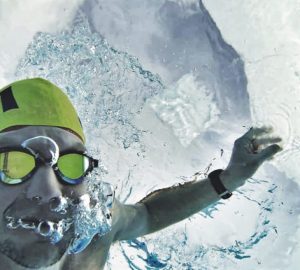6 Tips for Cold Water Swimming
Since lockdown restrictions eased, I’ve noticed a new wave of open water swimmers taking to our rivers, seas and lakes. In London where I live, booking slots at venues and lidos are snapped up as soon as they are released, with new swimmers taking to the open water as many indoor pools remain closed. As the water temperature begins to cool, many swimmers are deciding to swim outdoors longer into the autumn and venues up and down the country are extending their seasons to accommodate this new surge in cold water swimmers.
I have been swimming outdoors through all seasons for the past ten years. Now is one of my favourite times of year to swim, the water is cooling but is still warm enough to get in a long swim. It is a gentle easing in to the adrenaline rush of winter swimming. I choose to swim without a wetsuit, but whether you wear neoprene or not autumn swimming is a glorious experience and one of the ways I cope with the end of summer. If you want to keep swimming longer this year, my advice is – just keep swimming! The best way to acclimatise to colder water is to swim, reducing your times in the water as temperatures drop. Get into the water gently to avoid cold water shock, splashing yourself with water and ensuring your breathing is relaxed before submerging.
Whether you are planning to extend your season a bit longer than usual or are aiming to swim all through the winter, follow our tips for cold water swimming and check out our gear guide for all the kit you need to safely thrill to the chill.
1. Acclimatise
As the temperature drops, just keep swimming and your body will get used to the cold.
2. Be safe
Open water can be dangerous. Only ever swim where it is safe, and make sure you can enter and exit the water quickly and easily. Never swim on your own.
3. Wear the right kit
Wear a swimming hat, or two, to help preserve body heat. You can also wear neoprene gloves, booties, balaclava or a wetsuit – whatever you feel comfortable with.
4. No diving
Do not dive or jump in unless you are used to the cold water. Cold water can cause gasping of breath and cold water shock, which can be dangerous.
5. Know your limits
As the temperature drops, decrease the amount of time you spend in the water. In winter, swimmers often only swim for one or two minutes at a time.
6. Warm up slowly
Don’t have a hot shower. Hot water can cool your core and it can be dangerous. Instead, make sure you have plenty of warm clothes, wrap up well and have a hot drink.
Finally, spend the rest of the day on a high – cold water swimming can help combat depression as well as boost the immune system, circulation and even the libido.
Cold Water Swimming Kit Checklist
•
Swimming trunks or costume (optional, depending on location)
• Goggles
•
Two silicone hats (make sure the top hat features an impressive swim so everyone knows you are a serious swimmer!)
• Neoprene gloves
• Neoprene booties
• Neoprene hat
•
Wetsuit (suit or skins, wear whatever you feel comfortable in)
• Tow float
•
Changing robe
• Towel
• Flip flops or Crocs
• Woolly gloves
• Woolly hat
•
Layers, layers, layers (the best way to get warm after a cold swim)
• Flask
• Cake
Watch our cold water swimming video.








